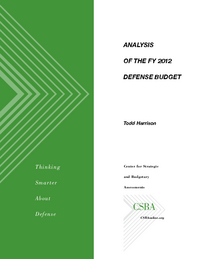
The FY 2012 budget requests a total of $676 billion for the Department of Defense (DoD). The base budget for DoD includes $553 billion in discretionary funding and $5 billion in mandatory funding, and an additional $118 billion is requested for the wars in Afghanistan and Iraq. The budget request also includes $19 billion for defense-related atomic energy programs and $8 billion for defense-related activities in other agencies, bringing the total national defense budget to $703 billion. Separately, the budget includes $129 billion for veterans’ benefits and services through the Department of Veterans Affairs.
The FY 2012 request grows the base defense budget by 3.0 percent in real terms from the level enacted in FY 2011. The war funding requested for FY 2012 is 27 percent less than the amount enacted for FY 2011, bringing it to the lowest level seen since FY 2005. The Future Years Defense Program (FYDP) submitted with the budget projects continued growth in the base defense budget through FY 2016, albeit at a slower rate than previously projected. The Department’s cumulative base budget over the FY 2012 FYDP is $78 billion less (in then-year dollars) than planned in the FY 2011 FYDP, a 2.6 percent reduction. While still allowing the base budget to grow, this represents the first significant reduction from one year’s FYDP to the next since FY 1996.
Adjusting for inflation, the level of funding proposed for the base defense budget in the FY 2012 request is the highest level since World War II, surpassing the Cold War peak of $531 billion (in FY 2012 dollars) reached in FY 1985. However, total national defense spending as a percent of GDP (measured using outlays rather than budget authority) is 4.7 percent in the FY 2012 budget request, below the post-World War II average of 6.3 percent. When measured as a fraction of overall federal government spending, national defense funding is 19 percent of the FY 2012 request, compared to an average level of 21 percent since FY 1976. Together, these three metrics indicate that defense spending is at a high level by historical standards but is affordable given the size of the U.S. economy and is consistent with modern-day norms as a portion of overall federal spending.



























